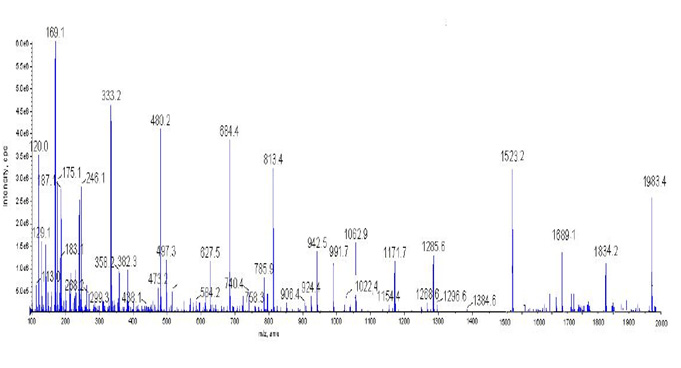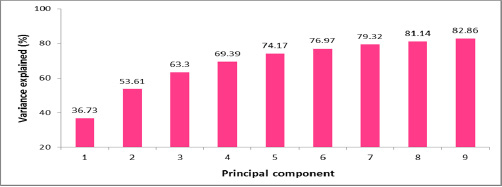Endocrinology and Physiology unit, School of Studies in Zoology and Biotechnology, Vikram University, Ujjain (M.P.)- 456010, India
Corresponding author Email: k1.kavitamukati@gmail.com
Article Publishing History
Received: 11/03/2017
Accepted After Revision: 28/06/2017
The effect of cadmium chloride on nucleus preopticus in Heteropneustes fossilis was analysed histologicalyl. Fish when treated with cadmium chloride of 0.5 ppm for 7,14, and 21 days exhibited degeneration, hypertrophy, reduced neurosecretory material and vacuolization in NPO. Their size was significantly (p<0.001) increased after cadmium chloride exposure. In ashawagandha recovery group, these nuclei displayed a gradual reorganization in structural detail and size. Recovery by a herbal compaund ashawagandha exhibited reduced hypertrophy and vacuolization in NPO.
Ashawagandha, Cadmium Chloride, Heteropneustus Fossilis, Nucleus Preopticus
Mukati K, Nagar B, Bhattacharya L. Effect of Cadmium Chloride on Nucleus Preopticus in Heteropneustes Fossilis and Its Recovery by Herbal Compound, Ashawagandha. Biosc.Biotech.Res.Comm. 2017;10(3).
Mukati K, Nagar B, Bhattacharya L. Effect of Cadmium Chloride on Nucleus Preopticus in Heteropneustes Fossilis and Its Recovery by Herbal Compound, Ashawagandha. Biosc.Biotech.Res.Comm. 2017;10(2). Available from: https://bit.ly/2FDtjUN
Introduction
Heavy metals occur naturally in the environment and are found in varying levels in ground and surface water. Heavy metals are reported as pollutants which caused the metabolic, physiological and structural alterations in fish (Jiraungkoorakul et al., 2007; 2008; 2009). Among heavy metal cadmium has been shown to be responsible for a number of reproductive abnormalities in fish (Sharma et al., 2013). The pituitary gland is one of the most important endocrine organs of fish. The histology of the pituitary of teleost fish has been described by a number of authors (Balcı et al., 2006; Ozen and Timur, 1993; Hibiya, 1982). The heavy metals (lead, cadmium, mercury etc.) are known to interfere with the endocrine system of model organisms such as mammals, fish etc. and lead to a disturbance in hormonal metabolism, hormone-regulated cellular of physiological processes(Colborn and Clement,1992; Kavlock et al.,1996). However, metal deterioration of hypothalamic nuclei in fish are not well illustrated. Since only in Heteropneustus fossilis (Shukla and Pandey,1984; Pandit and Bhattacharya, 2013)
Material and Methods
Heteropneustus fossilis measuring about length 12±5 cm and weight 25±5 gm were used in the present study. Cadmium was used for present study in the form of cadmium chloride (CdCl2). The dose of cadmium chloride was decided after determination of LC 50 value. It was found to be 0.5 ppm. The herbal compound Ashawagandha ( Withania somnifera) is used as recovery agent of damaged tissue. Fishes were acclimatized to laboratory condition for 7 days before the commencement of the experiment and were treated with 0.01 KMno4 solution to remove dermal infection . Fishes were fed with chopped prawn twice a day. The 72 hrs LC50 value of cadmium chloride was found to be 0.5 ppm in H. fossilis.
The fishes were divided in three groups having36 fishes in each one.
Fishes of all experiment groups (control, treated and recovery)were sacrificed each after 7,14, and 21 days. Pituitary with brain were fixed in aqueous Bouin’s solution for 24 hours. The material was washed with water, dehydrated and cleared through graded alcohol and xyline respectively after filtration in paraffin blocks were prepared and section of 5 µ thickness were cut and stretched on albumenized slides. The slides were stained with Chrome Alum Haematoxyline Phloxine (CAHP) (Gomori, 1941) stains and mount in DPX for histological observation. All the data and results for final observation were processed in the form of microphotographs and table. The diameter of NPO were recorded and difference if any were compared by statistical analysis using student ‘ t’ test (Bancroft, 1966).
| Table 1: Diameter of Nucleus preopticus of Heteropneustes fossilis in control and experimental group | ||||
| S. No | Experimental group | Days of exposure | ||
| 7 days | 14 days | 21 days | ||
| 1 | Control | 10.4±0.06 | 10.9±0.05 | 11.2±0.03 |
| 2 | Treated | 13.6±0.07** | 15.2±0.06*** | 17.9±0.03*** |
| 3 | Recovery Ashawagandha | 11.0±0.02** | 12.2±0.04** | 12.3±0.01** |
| All values are expressed in Mean ± SEM, Total no. of samples for each observation: 10, Significant level (**p < 0.05, ***p < 0.001). | ||||
| S. No. | Group | Treatment |
| 1 | Control | Water without CdCl2 + plain food |
| 2 | Treated | Exposed to 0.5ppm CdCl2 + plain food |
| 3 | Recovery by Ashawagandha | Exposed to 0.5ppm CdCl2 + Ashawgandha with food |
Results and Discussion
The hypothalamo-hypophysial neurosecretory system is a unique endocrine apparatus consisting of the cells of nucleus preopticus (NPO) in neurohypophysis. The nerve fibers of these hypothalamic nuclei terminate in the neurohypophysis.Nucleus preopticus is well developed in H. fossilis. These cells were spherical in shape with evenly distributed cytoplasm and their nuclear material. The nucleus usually contains a single nucleolus but sometime more than two nuclei were also observed. The perikarya of NPO cells were loaden with neurosecretory material. The neurosecretory cells of NPO were positive to AF and CAHP. Cellular differentiation was more marked after using CAHP technique. The hypothalamus of control fish exhibited the NPO neurons presented in their active secreting stage. The hypothalamic nuclei (NPO) exhibited strong affinity to CAHP and AF stain. (Fig. 1, 3 and 5)
Treated Groups
The hypothalamus of cadmium chloride treated fish after 7 days duration exhibited the NPO neurons were present in necrotic condition. The NPO neurons exhibited thick cell boundaries and clumping of cytoplasm. The cell as well as nuclei appeared turgid. The neurosecretory material in the perikarya of the cells was coarse. The cadmium chloride treatment induced deformities in these neuronal cells (Fig.2).
In fish exposed to cadmium chloride for 14 days duration, the hypothalamic nuclei (NPO and NLT) exhibited cytoplasmic and nuclear abnormalities and depletion of Neurosecretory material. The NPO cells showed degeneration in their cytoplasmic contents. Their cell boundaries were disappeared (Fig. 4).
After the treatment of cadmium chloride of 21 days duration these neurons presented exhausted condition due to cadmium stress. Some of the NPO cells showed hypertrophy. Degenerated cytoplasm and disappeared cell boundaries were observed in these cells. They had vacuolated cytoplasm (Fig. 6). Similar results were found by (Shukla and Pandey, 1984) in hypothalamic nuclei of Sarotherodon mossambicus exposed to DDT. While Katti and Sathaynesan (1986) reported degeneration of the NPO neurons in Clarias batrachus exposed to lead nitrate. Our findings corroborates with study of Ram and Joy (1988). The observed that the neurons containing less quantity of neuroscretory material and exhibited various degrees of degeneration and nuclear necrosis in Channa punctatus exposed to HgCl2 and methyl mercuric chloride of the dose.
Fig-1. Control group (7 days): Showing NPO cells stained brightly and neurosecretory material on the periphery of NPO cells visible.
Fig-2. Treated group (7 days): Showing fusion of NPO cells and atrophie condition, among neurons visible.
Fig-3. Control group (14 days): Showing NPO cell bodies with evenly distributed cytoplasm and clearly visible neurosecretory material.
Fig- 4. Treated group (14 days) : Showing deformed NPO cell bodies and their hypertrophied nature.
Fig-5. Control group (21 days): Showing NPO cells with their normal structural configuration.
Fig-6. Treated group (21days): Showing hypertrophied nature and vacuolization of cytoplasm in cell.
Recovery group: After 21 days treatment of cadmium chloride the fishes were administered with Ashawagandha.
In 7 days: After 7 days duration in Ashawagndha group the NPO exhibited reformed condition. Vacuolization was still present in their cytoplasm. Some of them were appeared with regenerated cytoplasm and their nuclear contents (Fig. 7 ) In 14 days In Ashawagndha recovery group the NPO cells showed reduced hypertrophy and increased population with some extent of neurosecretory material ( Fig. 8 ) In 21 days After 21 days duration the fishes of Ashawangndha recovery group showed signs of reconstitution in the neurons. In recovery group cellular hypertrophy still persisted in a few of NPO neurons. Most of them were in normal appearance. They had regenerated cytoplasm and nuclear contents (Fig. 9)
These observations were in good agreement with the study of Shukla and Pandey (1984). They postulated decreased size of hypothalamic nuclei in S. mossambicus exposed to DDT and BHC when kept in plain water. Pandit and Bhattacharya (2013) observed after Hgcl2 exposure NPO size were increased in the spirulina and chorella were effective to recover the histological changes in the NPO of H.fossilis.
Fig-7. Ashawagandha Recovery Group (7 days): Showing accumulation of neurosecretory material in NPO cells and vacuolization in their cytoplasm still
persist.
Fig-8. Ashawagndha Recovery Group (14 days): Showing still exhibited hypertrophied condition in a few NPO cells, most of them in normal appearance.
Fig-9. Ashawagndha Recovery Group (21 days): Showing regenerated cytoplasm and nuclear contents of cell body of NPO.
Abberviations
C-Cytoplasm, NPO-Nucleus preopticus
NSM-Neurosecretory material DN-Degenerated neurons
HN-Hypertrophied neurons, VN-Vacuolized neurons
RH-Reduced hypertrophy, RN-Regenerated neurons
RV-Reduced vacuolization
 |
Plate 1: Microphotographs of sections through hypothalamus showing NPO f Heteropneustes fossilis in control and treated group (7, 14 21 days, CAHP X1000) |
 |
Plate 2: Microphotographs of sections through hypothalamus showing NPO of Heteropneustes fossilis in recovery group (7, 14, 21 days, CAHP X1000) |
Acknowledgements
The authors are grateful to Dr. M.S. Parihar, Professor and Head, School of Studies in Zoology and Biotechnology Vikram University, Ujjain(M.P.) for providing necessary facilities to complete this work.
References
- Balcı, B.,˙Ikiz, B.R., Mutaf, B.F. (2006), Histomorphological comparison of pituitary gland of dusky grouper (Epinephelus guaza , 1758) and blacktip grouper (Epinephelus alexandrinus V., 1828). JFAS, 23: 183–186
- Bancroft, J.D. and Stevens, A. (1986), Theory and practice of histological techniques, 2nd edn. Churchill Livingstone, New York, 570.
- Colborn, T. and C. Clement. (1992), Chemically induced alterations in sexual and functional development: the wildlife/human connection Princeton Scientific Publishing. Princeton, N.J.
- Gomori G. (1941), Chromalum-haematoxylin phloxin method. Am. J. Pathol. 17, 395
- Hibiya, T. (1982): An Atlas of Fish Histology. Gustow Fischer Verlag, Stuttgart.
- Jiraungkoorakul, W., Sahaphong, S., Kangwanrangsan, N. and Kim. M. H., Histopathologcal study. (2006), The effect of ascorbic acid on cadmium exposure in fish (Puntius altus). J.Fish. Aquat. Sci.,1: 191-199
- Jiraungkoorakul, W., Sahaphong, S., Kangwanrangsan, N. and Kim. M. H., Histopathologcal study. (2007), The effect of ascorbic acid on cadmium exposure in gill of Puntius altus.int. J. Zool. Res.,3: 77-85
- Jiraungkoorakul,W., Sahaphong, S., Kangwanrangsan, N. and Zakaria. S. (2008), The protective influence of ascorbic acid against the genotoxicity of waterborne lead exposure in Nile tilapia oreochromis niloticus (L.). J.Fish Biol.,73 : 355-366
- Katti S.R. and Sathyanesan A.G. (1986), Changes in the hypothalamo-neurohypophysial complex to lead treated fish,Clarias batrachus (L), Z Mikrosk-anat. Forsch. Leipzig. 100, 347
- Kavlock, R.J., G.P. Daston, C. DeRosa, P. Fenner- Crisp, L.E. Gray, S. Kaatari, G. Lucier, M. Hecker, M.J. Mac, C. Mazka, R. Miller, J. Moore, R. Rolland, G. Scott, D. Sheehan, T. Sinks and H.A. Tilson. (1996), Research needs for the risk assessment of endocrine disruptors: a report of the US-EPA sponsored workshop. Environ. Health. Perspect., 102: 715-740
- Ozen, M.R., Timur, G. (1993), Lighted microscopic identification of cell types in carp, pike and vimba pituitary gland with histochemical methods. Dog˘a Turk. J. Biol.,17: 311–320
- Pandit, N. and Bhattacharya, L. (2013), Effect of mercuric chloride on nucleus preopticus in Heteropneustes fossilis and their recovery by spirulina and chlorella, International Journal of Research in BioSciences. 2 (4), 26-31,
- Ram R.N. and Joy K.P. (1988), Mercurial induced changes in hypothalamo-neurohypophysial complex in relation to reproduction in teleostean fish, Channa punctatus (Bloch), Bull. Environ. Contam. Toxicol. 41, 329
- Sharma, S., Vyas, V., Tamot, S., and Manhor, S. (2013), Histological changes in the testis of air–breathing fish, Heteropnuestes fossilis( Bloch) following Cadmium chloride exposure vol. 3, No.2,1216-1221
- Shukla L. and Pandey A.K. (1984), Histopathological responses of hypothalamic nuclei and their recovery in DDT stressed fish, Sarotherodon mossambicus, Nat. Acad. Sci. Lett. 7(10), 317-321


